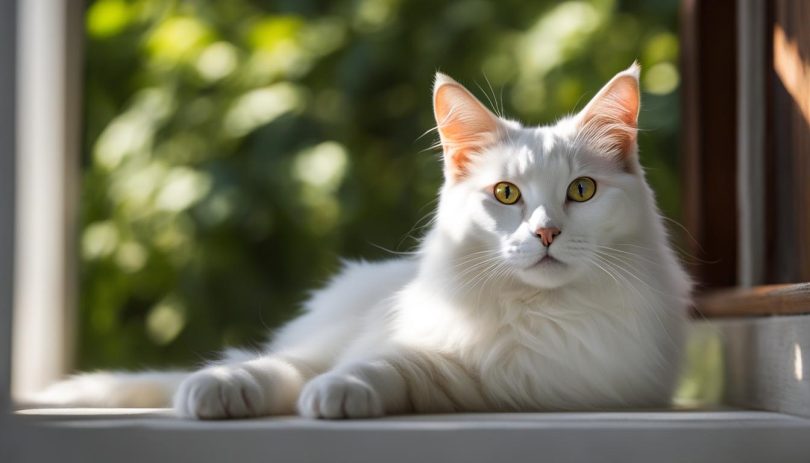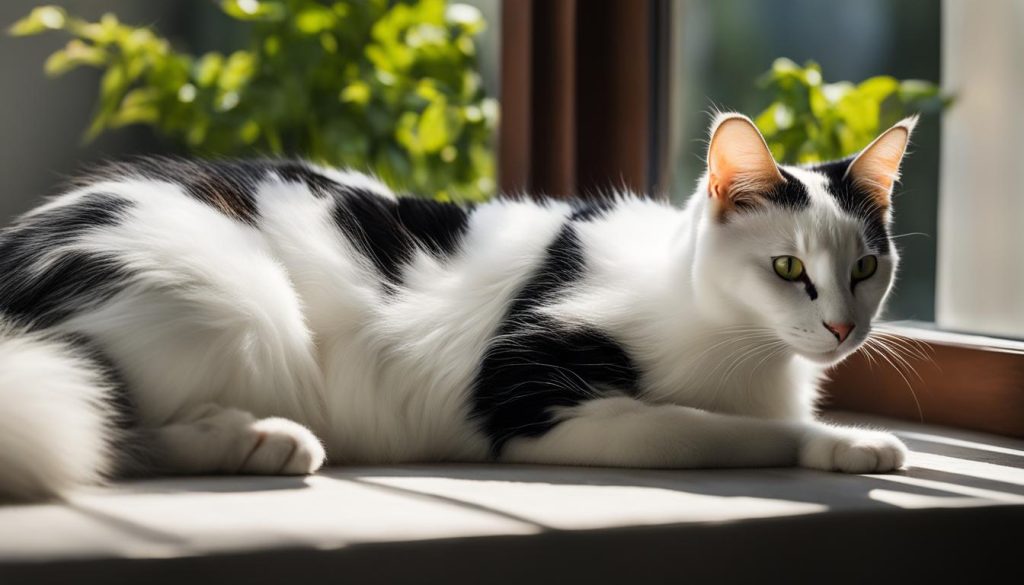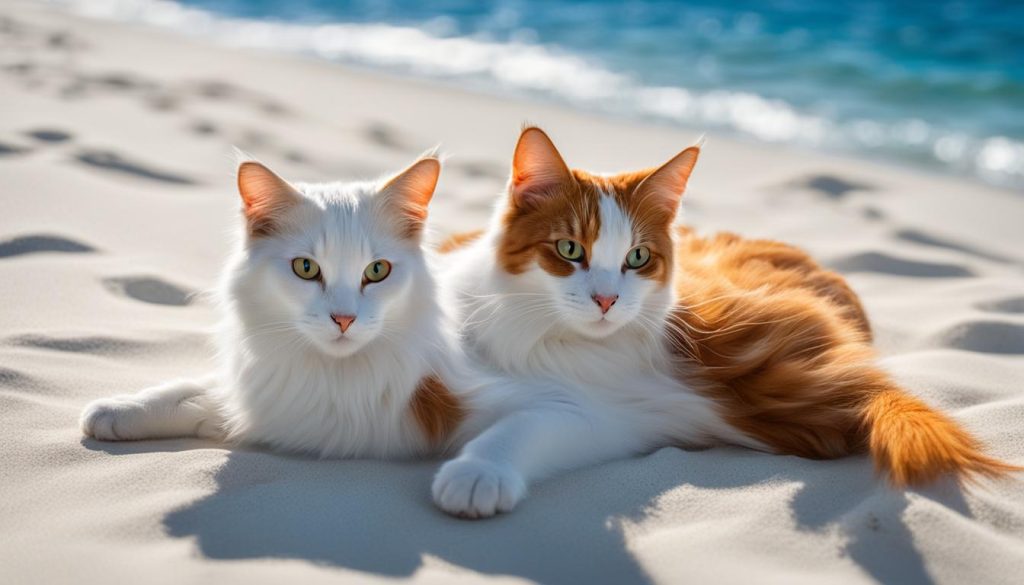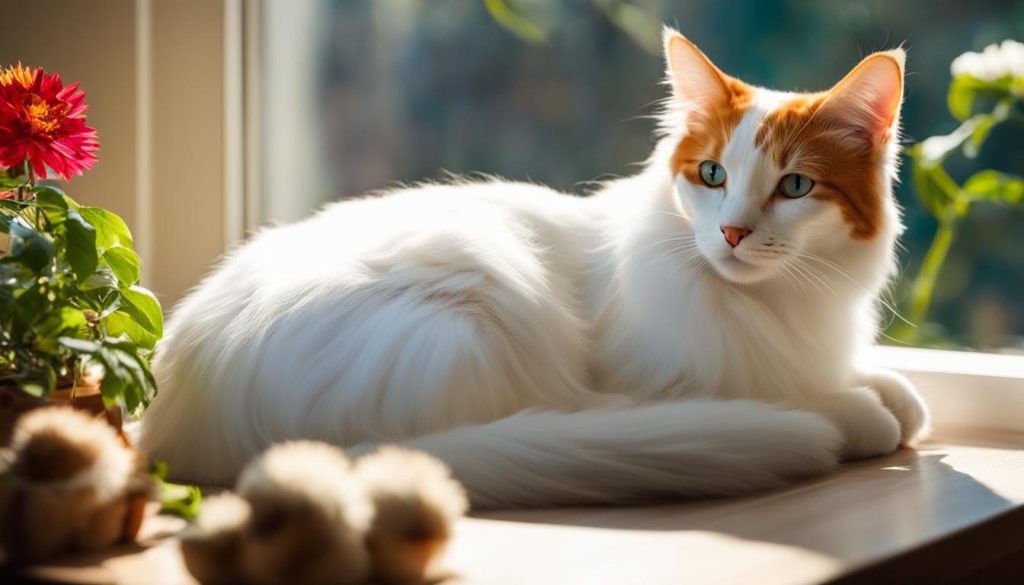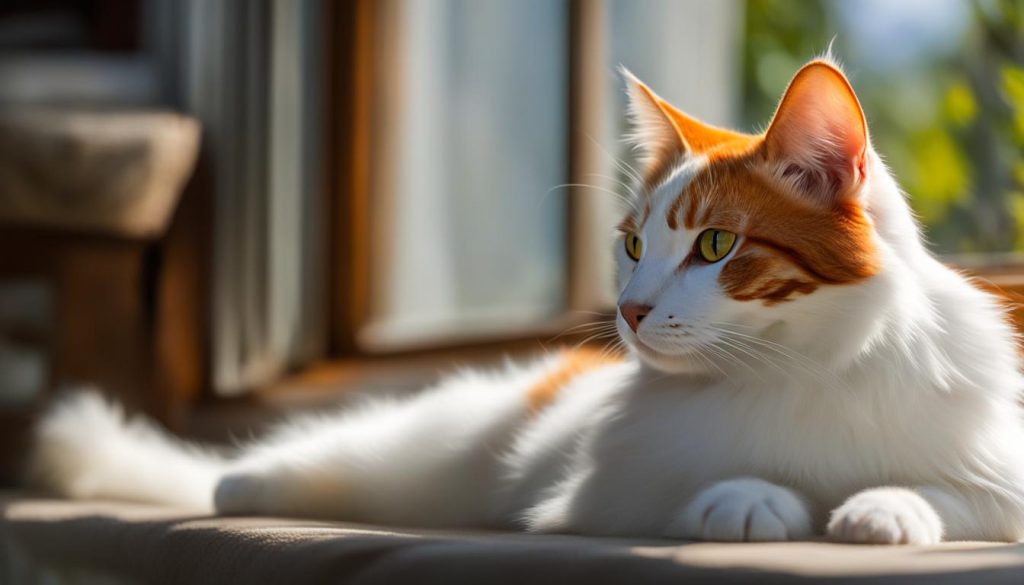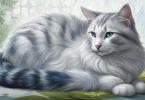As a cat lover, I have always been fascinated by unique breeds, and the Turkish Van Cat is no exception. Originating from Turkey, this longhaired breed is truly a sight to behold. With its striking coat pattern and captivating odd eyes, the Turkish Van Cat has captured my heart and sparked my curiosity.
The Turkish Van Cat is a rare gem among cat breeds, hailing from the Anatolian region of Turkey. Its coat, which is predominantly white with color patches limited to the tail and head, is truly stunning. The cat’s unique feature of having odd eyes, one blue and one amber, adds to its charm and allure.
Not only is the Turkish Van Cat visually striking, but it also possesses remarkable characteristics. This breed is known for its love of water, often surprising people with its willingness to take a dip. Additionally, Turkish Van Cats are friendly, playful, and make wonderful companions for those who appreciate their independent yet affectionate nature.
If you’re considering adding a Turkish Van Cat to your family, it’s important to learn more about this breed’s distinct characteristics and care requirements. In this article, I will share my personal experiences and provide valuable insights into the world of Turkish Van Cats.
Key Takeaways:
- The Turkish Van Cat is a unique longhaired breed from Turkey with a striking coat pattern.
- These cats have odd eyes, with one blue and one amber, adding to their charm.
- Turkish Van Cats are known for their love of water and playful, independent nature.
- Understanding the breed’s characteristics and care requirements is essential before adopting a Turkish Van Cat.
- The Turkish Van Cat is a rare and remarkable breed that can bring joy and companionship to any cat lover.
Turkish Van Cats: Breed History
The history of the Turkish Van cat breed is as fascinating as the breed itself. While the exact origin of Turkish Van cats is uncertain, it is believed that they have been in existence for centuries in the southeastern regions of Turkey. Some theories suggest that Crusaders may have brought these cats to Europe during their travels, indicating that the breed was already well-established by that time.
The Turkish Van breed first arrived in the United Kingdom in 1955 when a pair of cats named Princess and Bagdas were brought to England by Laura Lushington. These cats caught the attention of cat enthusiasts and were recognized by the Governing Council of the Cat Fancy (GCCF) in 1969. It wasn’t until 1982 that Turkish Van cats made their way to the United States, where they have since flourished and gained recognition from the Cat Fanciers’ Association (CFA) in 1994.
The Arrival of Turkish Van Cats in the UK and the US
The arrival of Turkish Van cats in the United Kingdom and the United States marked significant milestones in the breed’s history. Their unique coat pattern and striking appearance captured the hearts of cat lovers in both countries. Today, Turkish Van cats are cherished around the world for their beauty, charm, and playful nature.
As the breed continues to gain popularity, it’s important to remember the rich history that these cats carry with them. The story of the Turkish Van cat breed is a testament to the enduring appeal and mystique of these unique felines.
Turkish Van Cats: Breed Description
Turkish Van Cats are a breed known for their unique and striking appearance. They have a glistening chalk-white body with color patches limited to the tail and head. The head patches ideally form a symmetrical inverted V pattern, adding to their distinctive charm. The tail, on the other hand, can exhibit various colors such as red, cream, black, or blue, creating a beautiful contrast against the white body.
The coat of Turkish Van Cats is soft and cashmere-like, making them a pleasure to touch. Their eyes can be amber or blue, or a mesmerizing combination of both, enhancing their captivating gaze. In terms of body structure, Turkish Van Cats are sturdy and graceful. They have a moderately long and sturdy body, combining elegance and athleticism.
| Coat Pattern | Coat Color | Eye Color | Body Structure |
|---|---|---|---|
| The coat pattern of Turkish Van Cats is limited to color patches on the tail and head, forming a symmetrical inverted V pattern. | The body of Turkish Van Cats is primarily chalk-white, while the tail can exhibit various colors such as red, cream, black, or blue. | They have captivating eyes that can be amber or blue, or a combination of both, adding to their unique charm. | Turkish Van Cats have a sturdy and graceful body structure, with a moderately long and sturdy physique. |
Overall, Turkish Van Cats are a breed that stands out with their distinctive appearance, combining a white glistening body, color patches, and captivating eyes.
5 Fascinating Facts about Turkish Van Cats
As a proud owner of Turkish Van Cats, I have come across some fascinating facts about this unique breed. From their genetic marvel to their reputation as swimming cats, Turkish Van Cats never fail to amaze. Here are five intriguing facts that will make you appreciate these beautiful felines even more.
The Piebald Gene: A Genetic Marvel
Turkish Van Cats possess a genetic marvel known as the piebald gene. This gene is responsible for their distinctive coat pattern, where the majority of their body is white with patches of color limited to the tail and head. It’s truly a unique characteristic that sets them apart from other cat breeds.
Debunking the Myth: Not All Turkish Van Cats Swim
While there are stories of Turkish Van Cats enjoying swimming, not all of them share this trait. Some Turkish Van Cats may indeed have a fascination with water and enjoy splashing around, but it’s not a universal characteristic. Each cat has its own individual preferences and personality traits.
Distinct from Turkish Angora Breed
It’s essential to differentiate Turkish Van Cats from the Turkish Angora breed. Although both breeds originate from Turkey and have luxurious, long coats, they are distinct in terms of appearance and personality. Turkish Van Cats have a distinctive coat pattern and are known for their love of water, while Turkish Angoras have a solid coat color and do not typically exhibit a fondness for swimming.
Van Pattern in Other Cat Breeds
The coat pattern known as the “Van pattern” is not exclusive to Turkish Van Cats. It can also be found in other breeds, such as the British Shorthair and the Maine Coon. However, in Turkish Van Cats, the Van pattern is particularly striking due to the sharp contrast between the white body and the colored patches.
Rare Treasure: Low Popularity Among Recognized Breeds
Despite their unique characteristics and striking appearance, Turkish Van Cats are considered a rare treasure. They rank low in popularity among the recognized cat breeds, making them an exclusive and sought-after breed for cat enthusiasts.
Discovering these fascinating facts about Turkish Van Cats has deepened my admiration for this beautiful breed. Their genetic marvel, individuality regarding swimming, distinction from Turkish Angoras, the presence of the Van pattern in other breeds, and their rarity make them truly exceptional companions.
| Turkish Van Cats: 5 Fascinating Facts | |
|---|---|
| Fact | Description |
| Piebald Gene | Turkish Van Cats possess the genetic marvel of the piebald gene, giving them their unique coat pattern. |
| Swimming Cats | While some Turkish Van Cats enjoy swimming, not all of them share this trait. |
| Different from Turkish Angoras | Turkish Van Cats and Turkish Angoras are distinct breeds with different appearances and personalities. |
| Van Pattern | The Van pattern, characterized by a white body with color patches, can also be found in other cat breeds. |
| Rarity | Turkish Van Cats are a rare breed, ranking low in popularity among recognized cat breeds. |
Is My Cat a Turkish Van?
Turkish Van Cats are known for their unique coat pattern and striking appearance. If you have a cat that resembles a Turkish Van, you may wonder if it is indeed a member of this rare breed. While finding a purebred Turkish Van cat can be challenging, there are certain characteristics you can look for to help identify if your cat is a Turkish Van or a lookalike.
Coat Pattern: The most distinguishing feature of a Turkish Van cat is its coat pattern. Turkish Vans have a predominantly white body with color patches limited to the head and tail. The head patches typically form an inverted V pattern, while the tail can exhibit various colors. Look for these unique coat patterns as a potential indication that your cat may be a Turkish Van.
Eye Color: Turkish Van Cats can have amber or blue eyes, or a combination of both. This eye color variation is another characteristic that sets them apart. If your cat has striking amber or blue eyes, it could be a sign that it shares a genetic similarity with Turkish Vans.
| Turkish Van Cat Characteristics | Turkish Van Lookalike |
|---|---|
| Distinctive coat pattern with limited color patches | Coat pattern may resemble Turkish Van, but lacks the typical limited color patches |
| Eyes can be amber, blue, or a combination | Eye color may be different from the typical amber or blue |
| Sturdy and graceful body structure | Body structure may differ from the sturdy and graceful build |
Note: It’s important to remember that even if your cat has similar coat patterns or eye colors, it does not guarantee that it is a Turkish Van. Many cats can have coat patterns resembling Turkish Vans, but without proper documentation or lineage, it is challenging to determine their true breed.
Embrace the uniqueness of your cat, whether it is a Turkish Van or a lookalike. Lookalike cats can still be beautiful companions and provide love and companionship. If you are considering adopting a Turkish Van or a cat resembling this breed, make sure to provide a loving home and care for their specific needs.
Turkish Van Cats & Their Fascinating Facts
Turkish Van Cats are captivating not only because of their appearance but also because of their fascinating facts. From their unique coat pattern and luxurious texture to their eye colors and charming personality, Turkish Van Cats are truly a one-of-a-kind breed. Understanding the rare gene that gives them their coat pattern and debunking myths surrounding their love for water adds to their allure. These cats are an embodiment of grace, mystery, and elegance.
One remarkable fact about Turkish Van Cats is their distinct coat pattern. They have a chalk-white body with patches of color limited to their head and tail, forming a striking inverted V pattern on their head. This unique coloring is a result of a genetic marvel called the piebald gene. It gives them an exquisite appearance that sets them apart from other cat breeds.
Another fascinating fact about Turkish Van Cats is their eye colors. These cats can have amber eyes, blue eyes, or a striking combination of both. Their eyes are not only beautiful but also reflect their curious and intelligent nature. It’s this mesmerizing gaze that captures the hearts of many cat lovers.
While Turkish Van Cats are often associated with their love for water, it’s important to note that not all of them share this trait. While some Turkish Van Cats may enjoy playing in water, it’s not a characteristic that all individuals possess. However, their reputation as “swimming cats” adds to the charm and mystique surrounding this unique breed.
Turkish Van Cat Care & Health
As a proud owner of Turkish Van Cats, I can attest to their relatively low maintenance when it comes to grooming. Regular brushing is sufficient to keep their beautiful coat shiny and remove any dead hairs. Despite their love for water, regular baths are not necessary. These cats are self-groomers and take pride in keeping themselves clean.
When it comes to feeding, it’s important to provide a balanced diet tailored to their age, energy level, and breed. High-quality cat food that meets their nutritional needs is recommended. Additionally, it’s crucial to prioritize their dental care by providing dental treats or regularly brushing their teeth to maintain good oral health.
| Veterinary Care | Grooming | Feeding |
|---|---|---|
| Regular visits to the veterinarian are essential to ensure the overall health and well-being of your Turkish Van Cats. Vaccinations, preventative care, and annual check-ups are crucial in preventing common health issues. | Regular brushing is sufficient to remove dead hairs and keep their coat shiny. As self-groomers, Turkish Van Cats take pride in keeping themselves clean. | Provide a balanced diet tailored to their age, energy level, and breed. High-quality cat food that meets their nutritional needs is recommended. |
| Ensure their ears are clean and free from any dirt. Regular nail trims are necessary to prevent overgrowth and discomfort. | Regular brushing is sufficient to remove dead hairs and keep their coat shiny. As self-groomers, Turkish Van Cats take pride in keeping themselves clean. | Access to clean, fresh water at all times is important for their hydration. |
Lastly, providing regular veterinary care and addressing any health concerns promptly is crucial for the well-being of your Turkish Van Cats. Their health and happiness should always be a priority, and by following these care guidelines, you can ensure that they live a long and healthy life.
Turkish Van Cat Personality & Temperament
When it comes to personality, Turkish Van Cats are truly unique. They have a loving and loyal nature, forming strong bonds with their owners. However, they also have an independent streak and prefer to initiate contact rather than being overly demanding of attention. This makes them a perfect fit for individuals or families who appreciate a cat that is not overly clingy but still loves to be part of the household.
Playfulness is another characteristic of Turkish Van Cats. They have a curious nature and enjoy exploring their surroundings. Interactive play sessions using toys that simulate hunting can keep them engaged and satisfied. These cats are often described as having a mischievous side, and their antics can provide endless entertainment for their owners.
It is important to remember that every cat, regardless of breed, will have its own unique personality and temperament. While Turkish Van Cats are generally known for being affable and friendly, individual cats may still differ in their behavior. It’s important to spend time getting to know your cat and understand their specific needs and preferences.
“Turkish Van Cats are a delight to have around. Their playful nature and independent yet affectionate demeanor make them wonderful companions for those who appreciate their unique charm.” – Cat Lover Magazine
Characteristics of Turkish Van Cat Behavior:
- Playful and curious
- Loving and loyal
- Independent yet affectionate
- Mischievous and entertaining
- Enjoy interactive play sessions
| Personality Traits | Temperament |
|---|---|
| Loving | Playful |
| Loyal | Curious |
| Independent | Mischievous |
| Affectionate | Entertaining |
Turkish Van Cats: A Unique Addition to Your Family
As a cat lover, I can confidently say that Turkish Van Cats make a truly unique addition to any family. With their striking appearance and playful nature, these beautiful cats are sure to capture your heart. Whether you’re considering adopting a Turkish Van or simply intrigued by this rare breed, here’s what you need to know about having a Turkish Van as a pet.
Adopting a Turkish Van cat can be a rewarding experience. Their love for water and playful personality make them delightful companions. While they may not be suitable for families with young children who prefer to be held for long periods, they are loving and loyal pets who enjoy attention and cuddling. Keep in mind that Turkish Vans prefer to initiate contact, so be sure to respect their boundaries.
When it comes to compatibility with other pets, Turkish Van Cats generally get along well with their furry counterparts. However, a proper introduction may be necessary to ensure a smooth transition. Each cat has its own unique personality, so it’s important to monitor their interactions and provide a safe and harmonious environment for all pets involved.
| Turkish Van Cats: A Unique Addition to Your Family | |
|---|---|
| Turkish Van Cat Breed | Anatolian Turkish Van |
| Turkish Van Cat as a Pet | Delightful companions with a love for water and playful nature |
| Adopting Turkish Van Cats | Rewarding experience for those seeking a unique and rare breed |
| Compatibility with Other Pets | Generally get along well, but require a proper introduction |
In conclusion, Turkish Van Cats are not your average feline companions. They bring a touch of elegance and charm to any household. With their striking appearance, playful personality, and compatibility with other pets, these unique cats can make a wonderful addition to your family. Consider adopting a Turkish Van and experience the joy and companionship they have to offer.
Conclusion
In conclusion, the Turkish Van Cat is truly a remarkable breed that captures the imagination with its unique appearance and fascinating characteristics. With their origins in southeast Turkey, these cats have a rich history that dates back centuries. They arrived in the United Kingdom in the 1950s and later made their way to the United States, where they have since flourished.
One of the most striking features of the Turkish Van Cat is its distinctive coat pattern. The glistening chalk-white body with color patches limited to the tail and head creates a visually stunning look. Their eyes, which can be amber or blue, or a combination of both, add to their allure.
Not only are Turkish Van Cats beautiful, but they also have some fascinating facts associated with them. From the genetic marvel of the piebald gene that gives them their unique coat pattern to the myth of their love for water, these cats never fail to intrigue. Their playful and mischievous nature adds to their charm, making them a delightful addition to any family.
In summary, the Turkish Van Cat is a breed that embodies elegance and splendor. Their captivating appearance, playful personality, and unique characteristics make them a truly one-of-a-kind companion. Whether you are a proud owner or simply fascinated by their allure, the Turkish Van Cat is sure to leave a lasting impression.
FAQ
What is the origin of the Turkish Van cat breed?
The exact origin of the Turkish Van cat breed remains uncertain, but it is believed to have originated in southeast Turkey.
When did Turkish Van cats arrive in the United Kingdom and the United States?
Turkish Van cats arrived in the United Kingdom in 1955 and gained recognition from the Governing Council of the Cat Fancy (GCCF) in 1969. They arrived in the United States in 1982 and gained recognition from the Cat Fanciers’ Association (CFA) in 1994.
What is the coat pattern of Turkish Van cats?
Turkish Van cats have a glistening chalk-white body with color patches limited to the tail and head. The head patches should ideally form a symmetrical inverted V pattern, and the tail can exhibit various colors such as red, cream, black, or blue.
What are the distinguishing features of Turkish Van cats?
Turkish Van cats have a sturdy and graceful body structure with a moderately long and sturdy body. They also have a soft and cashmere-like coat and can have amber or blue eyes, or a combination of both.
Are Turkish Van cats the same as Turkish Angora cats?
No, Turkish Van cats are distinct from the Turkish Angora breed. While they both come from Turkey, they have different coat patterns and characteristics.
Are Turkish Van cats the only ones with the “Van pattern” coat?
No, the coat pattern known as the “Van pattern” can be found in other cat breeds as well.
Are Turkish Van cats rare?
Yes, Turkish Van cats are a rare treasure and ranked low in popularity among recognized cat breeds.
How can I tell if my cat is a Turkish Van?
While finding a purebred Turkish Van in a shelter or on the streets is unlikely, some lookalike cats may resemble this breed. However, having a similar coat pattern does not necessarily make them a Turkish Van.
How should I care for a Turkish Van cat?
Turkish Van cats are relatively low maintenance when it comes to grooming. Regular brushing is sufficient to remove dead hairs, and baths are not necessary. Providing proper dental care, checking their ears for dirt, and trimming their nails regularly are important. Feeding should be tailored to their age, energy level, and breed, with access to clean, fresh water at all times. Regular visits to the veterinarian for vaccinations and preventive care are crucial.
What is the personality of Turkish Van cats like?
Turkish Van cats have a loving and loyal personality. They enjoy attention and cuddling but prefer to initiate contact. They are playful, curious, and often join in their owner’s activities. They can be mischievous and provide hours of entertainment. Interactive play and providing them with toys are important to satisfy their energetic nature.
Are Turkish Van cats suitable for families with young children?
Turkish Van cats are not recommended for families with young children, as they generally prefer not to be held for long periods. However, they can bring joy and companionship to those who understand their unique personality.
